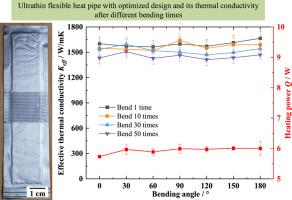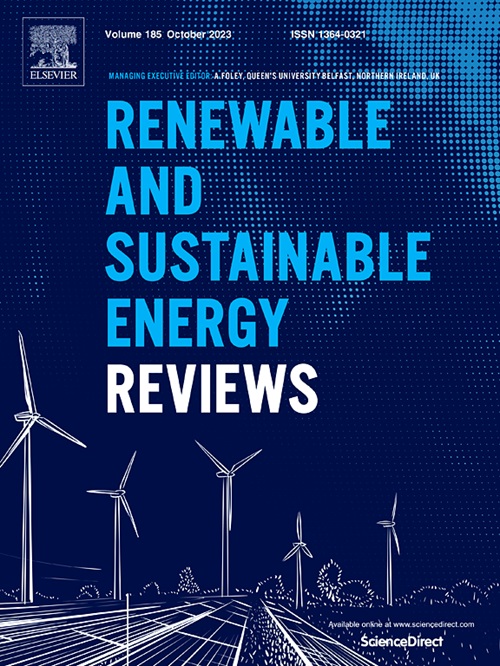Ultrathin flexible heat pipes with heat transfer performance and flexibility optimization for flexible electronic devices
IF 16.3
1区 工程技术
Q1 ENERGY & FUELS
引用次数: 0
Abstract
Ultrathin flexible heat pipes (UFHPs) are considered an ideal solution to the heat dissipation problem of flexible optoelectronics. However, the relatively poor heat transfer performance and flexibility of UFHPs greatly limit their application. In this study, laser ablation and embossing were adopted to optimize the comprehensive performances of UFHPs. The laser ablation removed the oxidized Nylon layer of the casing to reduce its thermal resistance, and the embossing process generated corrugated structures on the casing to enhance flexibility. The experimental results showed that removing the oxidized Nylon layer increases the thermal conductivity of UFHPs by 44.2–67.2 %, and the maximum thermal conductivity of UTHPs with a thickness of 0.63 mm reached 2423.7 W/m·K under forced water cooling conditions. The thermal conductivity could be further improved considering the casing still has polymer layers with a total thickness of 35 μm. Additionally, the thermal conductivity attenuation rates of UFHPs after repeated bending 50 times decreased from 73.2 % to 11.8 % when corrugated structures were applied. Under natural convective conditions, UFHPs with optimized design decreased the heater temperature by 11.7–16.1 % compared to the 0.7 mm copper plate. Further, they exhibited a consistent temperature distribution even after being bent 50 times. The corrugated structures reduced the elastic modulus of the casing, which avoided the formation of wrinkles during repeated bending and ensured the low resistance flow of vapor. The optimization techniques explored in this study offer a promising framework for enhancing and manufacturing high-performance UFHPs to meet the growing demands for heat dissipation in advanced optoelectronics.

为柔性电子设备优化传热性能和柔性的超薄柔性热管
超薄柔性热管(UFHP)被认为是解决柔性光电子散热问题的理想方案。然而,超薄柔性热管相对较差的传热性能和柔韧性极大地限制了其应用。本研究采用激光烧蚀和压花技术来优化超高频热电偶的综合性能。激光烧蚀可去除套管上的氧化尼龙层,降低其热阻;压花工艺可在套管上形成波纹结构,增强其柔韧性。实验结果表明,去除氧化尼龙层后,超高压陶瓷的热导率提高了 44.2-67.2%,在强制水冷条件下,厚度为 0.63 mm 的超高压陶瓷的最大热导率达到 2423.7 W/m-K。考虑到外壳中仍有总厚度为 35 μm 的聚合物层,导热率还可以进一步提高。此外,当采用波纹结构时,超高压陶瓷在反复弯曲 50 次后的热导率衰减率从 73.2% 降至 11.8%。在自然对流条件下,与 0.7 毫米的铜板相比,经过优化设计的超高频热电偶的加热器温度降低了 11.7%-16.1%。此外,即使弯曲 50 次,它们也能表现出一致的温度分布。波纹结构降低了外壳的弹性模量,从而避免了在反复弯曲过程中形成皱褶,并确保了蒸汽的低阻力流动。本研究中探索的优化技术为增强和制造高性能超高压热电偶提供了一个前景广阔的框架,以满足先进光电子领域日益增长的散热需求。
本文章由计算机程序翻译,如有差异,请以英文原文为准。
求助全文
约1分钟内获得全文
求助全文
来源期刊

Renewable and Sustainable Energy Reviews
工程技术-能源与燃料
CiteScore
31.20
自引率
5.70%
发文量
1055
审稿时长
62 days
期刊介绍:
The mission of Renewable and Sustainable Energy Reviews is to disseminate the most compelling and pertinent critical insights in renewable and sustainable energy, fostering collaboration among the research community, private sector, and policy and decision makers. The journal aims to exchange challenges, solutions, innovative concepts, and technologies, contributing to sustainable development, the transition to a low-carbon future, and the attainment of emissions targets outlined by the United Nations Framework Convention on Climate Change.
Renewable and Sustainable Energy Reviews publishes a diverse range of content, including review papers, original research, case studies, and analyses of new technologies, all featuring a substantial review component such as critique, comparison, or analysis. Introducing a distinctive paper type, Expert Insights, the journal presents commissioned mini-reviews authored by field leaders, addressing topics of significant interest. Case studies undergo consideration only if they showcase the work's applicability to other regions or contribute valuable insights to the broader field of renewable and sustainable energy. Notably, a bibliographic or literature review lacking critical analysis is deemed unsuitable for publication.
 求助内容:
求助内容: 应助结果提醒方式:
应助结果提醒方式:


